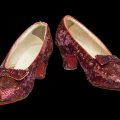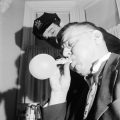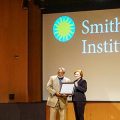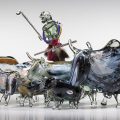They’re not in Kansas any more: The Case of the Stolen Slippers
“The Wizard of Oz” premiered on August 25, 1939. Eighty years later, the film is an icon of American culture and Dorothy’s ruby slippers are the most-visited object at the American History Museum. Erin Blasco takes us behind the scenes as Smithsonian curators help the FBI solve a real-life crime mystery involving those very slippers.
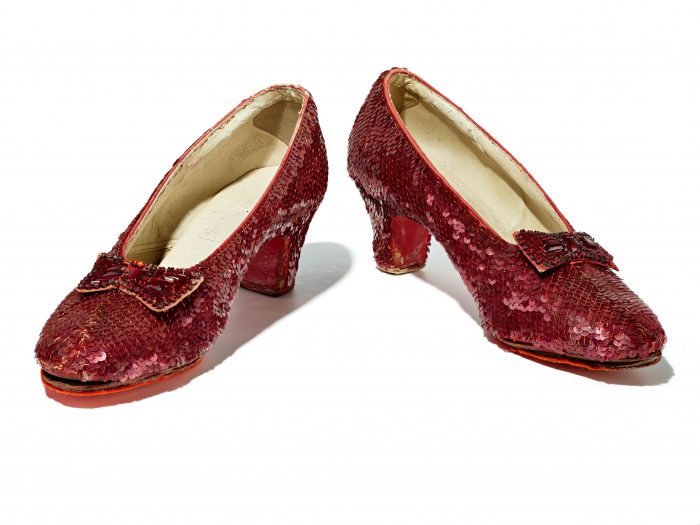
The Ruby Slippers in the museum’s collection, shown here, are one of a few pairs made for the movie. Our pair was likely worn in dance sequences. Felt on the bottom of the shoes may have muffled the sound of dancing on the Yellow Brick Road. This photo was taken after the completion of the conservation treatment. (National Museum of American History)
Dawn Wallace and Richard Barden stood in the museum’s objects conservation lab over two shoes. Red. Sequin-covered. Small heels. Petite in size.
Wallace, an objects conservator, had recently spent more than 200 hours examining the museum’s long-cherished pair of Ruby Slippers, worn by Judy Garland while filming the iconic 1939 movie The Wizard of Oz. Barden, our chief conservator, had spent decades with the museum’s collections, including the sparkling shoes that will be returning to view in a new showcase display opening October 19, 2018.
Those shoes, now fully conserved thanks to the support of 6,000 Kickstarter backers who funded their preservation, were safely stored elsewhere in the museum. The shoes that sat before Wallace and Barden had been delivered by FBI agents for examination, and could be the key to a 13-year-old mystery.
“Wow, I think these are the real thing,” Wallace thought.
An unexpected examination
Of the several pairs of shoes used during filming, only four are known to have survived. In addition to our own pair of Ruby Slippers, one pair is in the hands of a private collector, one pair is on display at the Academy of Motion Picture Arts and Sciences museum, and one pair of slippers disappearedolen in 2005 while on loan to the Judy Garland Museum in Minnesota. At the FBI’s request, Wallace and Barden were looking for signs that the recovered pair might be the missing shoes. Was this pair a masterful replica, or would evidence suggest that these shoes were worn by Garland as she worked on the film?

The recovered pair, along with an FBI badge. The single sequin shown here was found at the crime scene at the Judy Garland Museum, from which a pair of Ruby Slippers went missing in 2005. (National Museum of American History)
Wallace and her colleagues would spend nearly two days poring over every detail to assist the FBI in learning as much as possible about the glistening red shoes the agents had brought to the museum.
National Museum of American History staff do not authenticate objects, but often share knowledge when asked—and, of course, relish “the opportunity to learn more about objects that are so important to American history,” as Entertainment Curator Ryan Lintelman put it. Wallace and Barden were eager to use their expertise to determine if the recovered pair’s materials, construction, and condition were consistent with the museum’s pair.
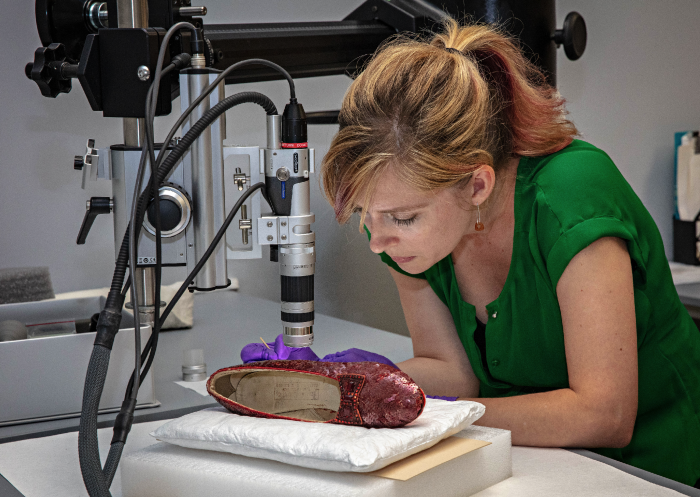
Objects Conservator Dawn Wallace examines the recovered pair of Ruby Slippers. Chief Conservator Richard Barden and Curator Ryan Lintelman also spent hours looking at the shoes in detail.
Wallace checked every inch of the shoes. Her hours with our Ruby Slippers made her uniquely qualified to spot any minute clues the shoes may offer. The conservation work was a “sequin by sequin sequence,” she likes to joke. During that process, she cleaned each sequin, realigning many to expose the silver side with more reflectance and stabilizing the shoes so that they can be on display for years to come.
Investigating the materials and their condition, Wallace noticed many consistencies with the museum’s pair. But it was a clear glass bead on the bow of the left shoe that, for her, confirmed her initial reaction.
A clear glass clue
Wallace had also spotted clear glass beads painted red while peering through a microscope during conservation work on the museum’s pair. Analysis and interviews with Hollywood costumers indicated that the painted-bead replacements were likely repairs made on-set during filming.
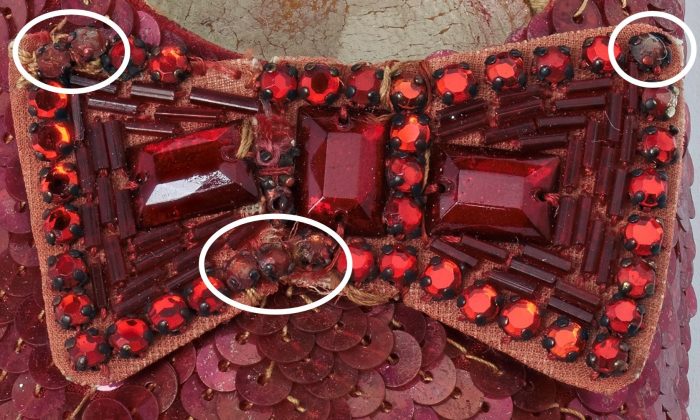
Circles indicate the location of clear glass beads painted red on the museum’s right shoe. (National Museum of American History)
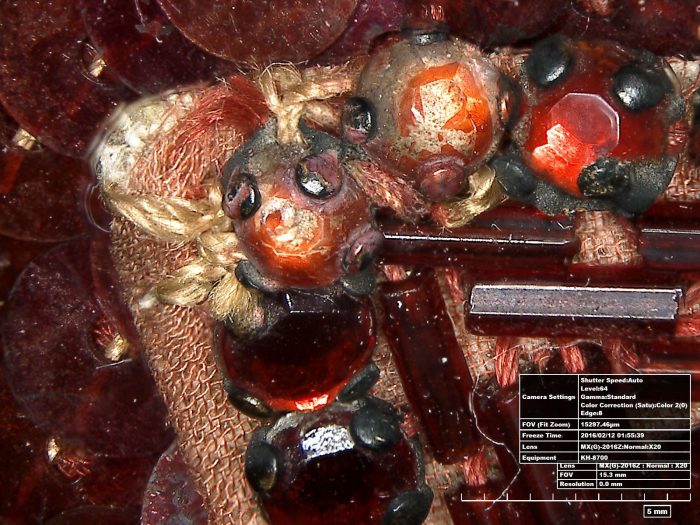
This close-up image of the bow on the museum’s right shoe shows two clear beads with red paint beside two red glass beads, evidence of an on-set repair. In bottom right is information about the microscope used to capture this image. (National Museum of American History)
“To me, the glass bead painted red was a eureka moment,” Wallace said. “That’s a piece of information that hasn’t been published anywhere and, as far as I know, isn’t widely known. It’s a unique element of these shoes, and spotting that bead was a defining moment.”
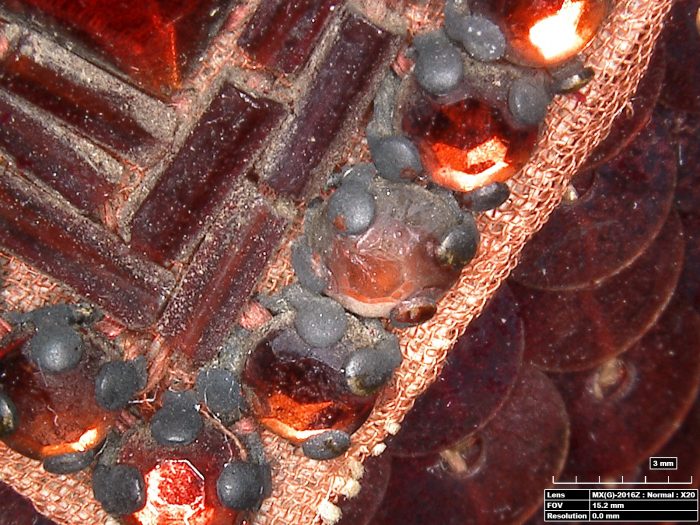
A clear glass bead is discovered on the bow of the left shoe of the recovered pair. It has flecks of red paint on it. (National Museum of American History)
In addition to examining the shoes, Wallace worked with scientists from the Smithsonian Institution’s Museum Conservation Institute to analyze their materials using a non-destructive process. They could then compare results between the two pairs. Analysis revealed, for example, that the sequins combine layers of different materials, including cellulose nitrate and a silver backing designed to reflect light and create a sparkle. (Modern sequins have aluminum instead of silver.)
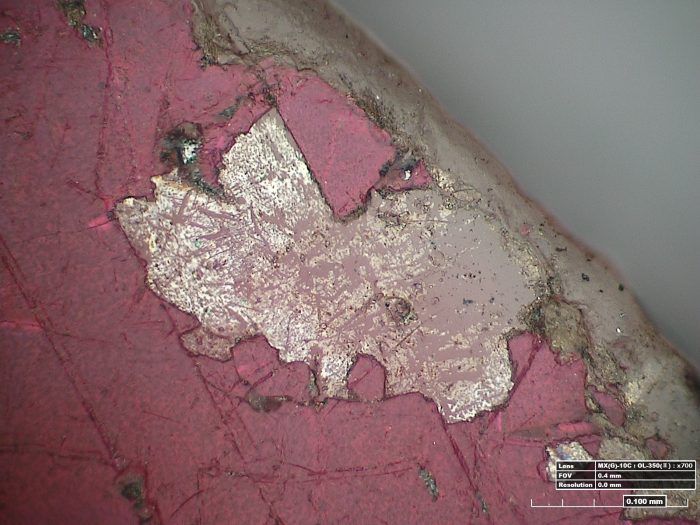
This is a close-up image of a sequin that came off the museum’s pair of Ruby Slippers many years ago and has been saved for study. The red coating has flaked, showing the silver reflective layer and gelatin core. This combination of materials presents a preservation challenge as each material may react to light, temperature, and humidity differently—issues museum staff had to navigate while designing a sophisticated display case that would preserve the shoes in just the right environment when they return to display in October 2018. (National Museum of American History)
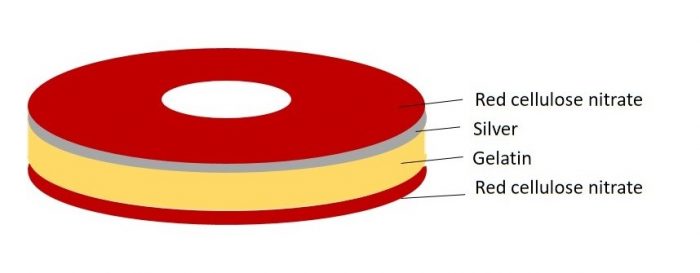
Sequins aren’t so simple. This diagram shows the different layers present in each sequin of the Ruby Slippers.
For Barden, the “aha!” moment came while examining the level of deterioration of the recovered pair’s sequins. The physical and light damage is consistent with the museum’s pair. To replicate this type of aging, one would have to have specialized knowledge.
“Because of our conservation work on the Ruby Slippers, we created basically a library of information about the shoes,” Wallace said. “And we were able to apply that to the pair the FBI brought here and gain more information.” The MCI scientists, with Wallace and Barden, plan to publish about the project in the journal Heritage Science this fall and present their findings at conferences to help other museum professionals care for objects like these.
A second solve
The clear glass beads, painted red, offered another surprising insight that, unexpectedly, linked the museum’s pair to the recovered pair. The museum’s pair is not identical. The heel caps, bows, width, and overall shape do not match; the shoes were brought together from two separate sets. But in examining the recovered shoes, conservators found the left to the museum’s right and the right to the museum’s left. When temporarily reunited, the four shoes created two matching pairs.
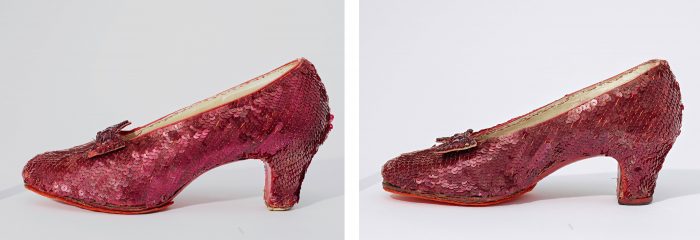
Subtle differences are visible between the two shoes in the museum’s pair of Ruby Slippers. The heel caps, for example, aren’t identical. (National Museum of American History)

The inner heel grips differ dramatically in shape between the two shoes in the museum’s collection. The bows are also slightly different. (National Museum of American History)
It’s possible the mix-up happened during preparation for the 1970 auction of items in MGM’s costume closets. That’s when the museum’s pair was purchased—parting ways from other pairs produced for the film—and donated to the museum anonymously in 1979. Both our pair and the recovered pair have felt on the bottom for dance sequences. The Ruby Slippers used in close-ups would have been felt-free.
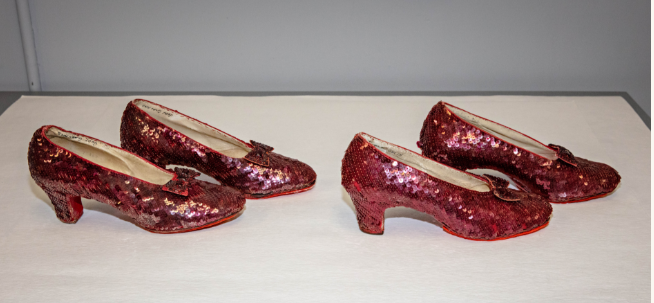
The recovered pair on the left, the museum’s pair on the right. Both are mismatched sets that were briefly reunited during examination by museum experts. (National Museum of American History)
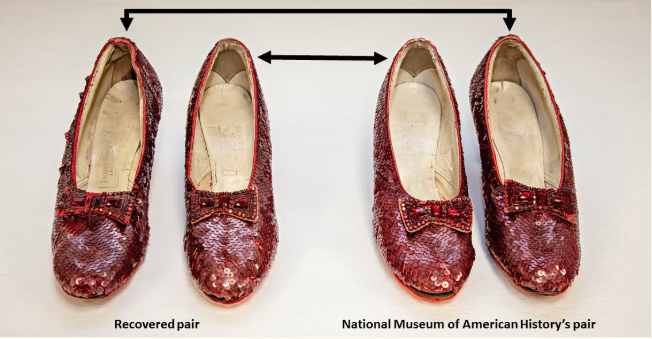
How do the shoes make matching pairs? The recovered left shoe goes with our right shoe and vice versa.
A pair of shoes, a national treasure
“It was a great experience to see the recovered pair of shoes, for us at the museum,” Lintelman said. “The Ruby Slippers have this unique resonance with the public—people watched this movie as kids or over the holidays. . . . It’s a shared experience, an adventure story, a fairy tale.”
We were honored to be able to share our knowledge, play a role in the recovery of lost history, and continue learning about The Wizard of Oz history. .
Erin Blasco is Social Media manager for the Smithsonian; she formerly managed the American History Museum’s social media and blog, O Say Can You See, where this post originally appeared.
Anyone with information regarding this issue is encouraged to contact the FBI.
Posted: 25 August 2019
-
Categories:
American History Museum , Collaboration , Feature Stories , History and Culture
